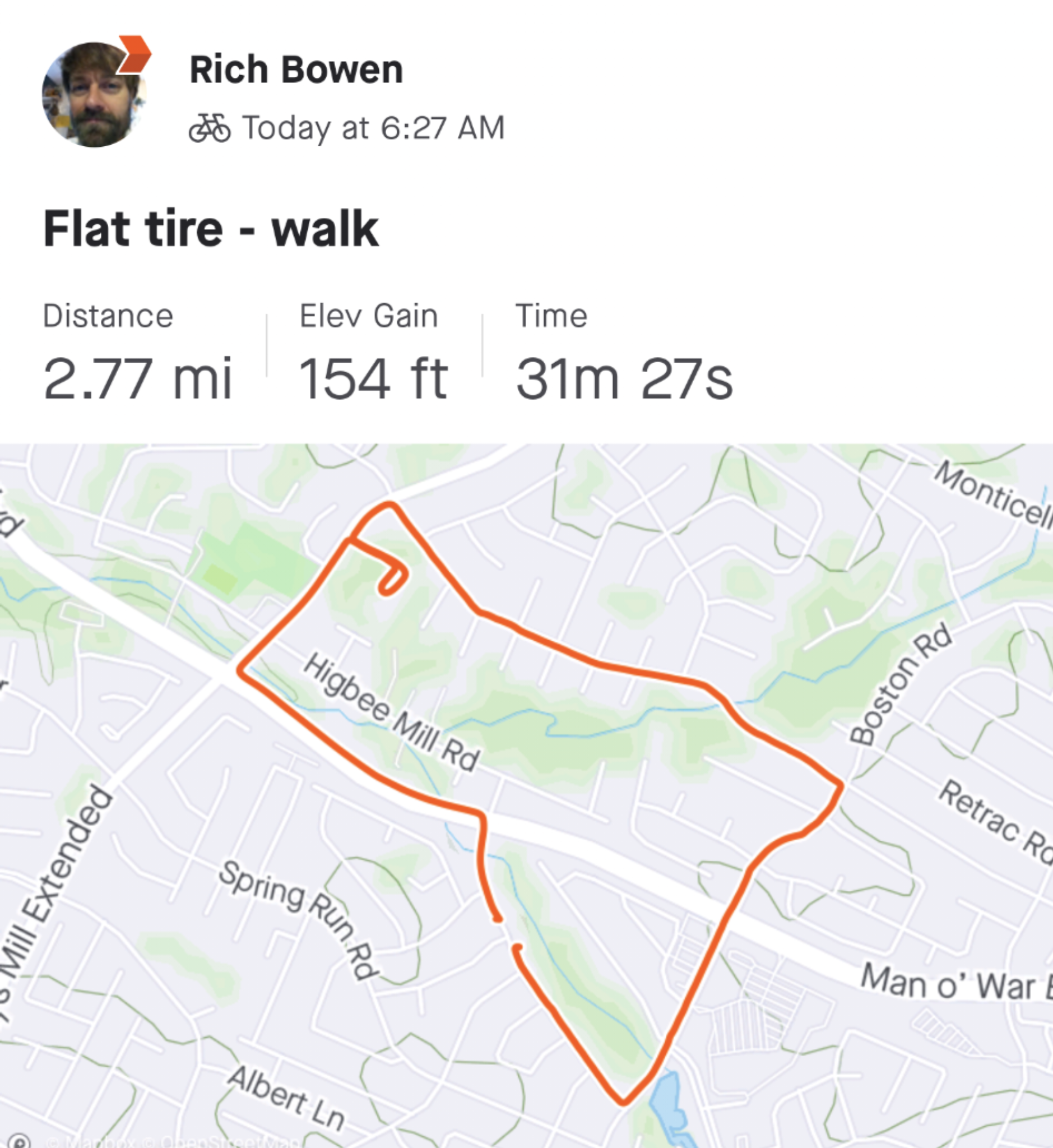Category Archives: Uncategorized
The problem with getting up at 6…

100 miles
I know some of y’all hit a hundred miles on January 2nd, but this is kind of a big deal for me.

Morning run… ish

I attempted to run this morning and it was a sad failure. 11-minute miles and my legs have been protesting all day. But the bike is still getting repaired and I have to do something so I don’t break my marvelous new exercise habit. Just a few more days and I’ll have the bike back.
Flat tire
On Friday I took my bike in to get the brakes and gears serviced. I was planning to borrow Z’s bike for a couple days.
About a mile out this morning a back tire started going bumpity bumpity. Flat tire. I had to walk the rest of the way home and I decided to complete the loop anyway.
And it’s got a pretty significant hole in it. It’s pretty obvious when you try to pump it up. So now I am without a bike for a week, and I can’t take Z’s bike in to get serviced until Tuesday. So I’m not sure what I’m going to do in the morning.
It’s weird because the last few times I tried to start biking I really didn’t get into it. And now that I have to take a few days off I’m really irritated.
Bigger fish
This is something that both irritates and perplexes me – people who, when faced with a proposal for a positive change, respond with “aren’t there bigger problems to solve?”
Almost nobody has the power and influence to solve the big problems. Those that do, for the most part, are using that power to enrich themselves, not to solve those big problems.
All big changes are comprised of hundreds or thousands of small changes. Most of us only have the power to make those small changes. To discourage people wishing to make small changes, because there are bigger problems which they cannot solve, is defeatist nonsense.
Solve the problem that’s in front of you. Ignore the people who tell you you should be using your time and energy to solve other things. Be who you are. Use the tools you have, not those that you don’t.
Tyranny grows on live TV
Two days ago the President of the United States, angered that the media had reported that he was hiding in his basement, ordered peaceful protesters in front of the White House to be dispersed, using tear gas and rubber bullets, so that he could cross the street to stand in front of St. John’s Church and have his photo taken holding a Bible. This was both a flagrant violation of the First Amendment, and a shameless use of the Church and the Bible – neither of which he has anything to do with – to support his personal image.
I provide that paragraph because I’m sure, looking back on this in 10 years, the context will be blurry, and it will be hard to believe that this really happened. When my sister told me, Monday night, that it had just happened, I thought it was the setup for a joke.
And, yet, the narrative has gone exactly the way we could have predicted. They were violent rioters. (The video footage proves this to be false.) They attacked the police. (Again, not true.) It wasn’t actually tear gas. (Hundreds of people that were there say that it was.) The incident was simply coincidental to the President’s little walk, and not done specifically so he could get his photo op. The President didn’t order it himself. The entire thing was faked with videos from elsewhere and put together in a studio.
A few Republican Senators have made vague disapproving noises. Alexandria Ocasio-Cortez has made her expected snarky remark. Elizabeth Warren and Nancy Pelosi have made strongly worded statements.
And in the midst of it all, the President has managed to make the narrative about him, rather than about the protest themselves, and the gross injustices that they are are calling out.
Each time, the President’s actions are less defensible. And each time, his supporters’ defenses are easier and easier lies. They’re barely even trying any more, because they know that nothing will be done. They know that the Senate is firmly under his thumb, because of their insatiable greed for power and reelection.
This is only going to get worse, as long as Donald Trump occupies the White House.
How the lion … audio version
Here’s an audio version of my recent story, “How the lion (and the Maasai) got his mane”, for the 3 people that still subscribe to my podcast feed.
TaskWarrior
I’ve been using ToDo.txt for several years now. I wrote about it HERE. It allows me to manage my task list from the command line, which is where I spend a lot of my time already.
Yesterday, Vipul introduced me to Taskwarrior, and I’m switching.
Everything I said about ToDo.txt is still the case with Taskwarrior, but it offers so much more with exactly the same ease of use.
The only thing missing from Taskwarrior that ToDo.txt has is the ability to sync the task data to an Android device. But it turns out that I almost never use that feature anyway, so no great loss.
In addition to what I was already doing (t add to add a task, t done to mark it done) I get reporting, recurring events, and task interdependence, three things that I always felt were missing from Todo.txt.
I recommend you have a look at Taskwarrior if you, like me, use the command line a lot, and are looking for a full-featured task manager.
How the Lion (And the Maasai) Got His Mane
A Just So Story by Richard Bowen
Long ago in Africa, the Lion, Oh my best Beloved, looked exactly the same as the Lioness. The same beautiful tawny coat. The same sharp teeth and claws. The same terrifying roar. They hunted together, and killed together, and were feared by every animal on the vast veldt, and were called the Tsovereigns of the Tsavo.
However, as is the way of the males of all species, the Lion was vain, and discontent. He went to his wife and said, “Oh my beloved, and oh my hunting partner, you are beautiful and the best hunter in the world. We are feared by all creatures, from the Hyrax to the Hippopotamus. But, my love, why is it that the menfolk of the birds of the air, and of the antelopes of the savannah, have beautiful ornaments, while their womenfolk are drab. I fear that they are secretly laughing at me behind my back.”
And his wife, who was wise, said “Shut up and hunt.”
Still discontent, the Lion went to visit Peacock. After assuring Peacock that he wasn’t going to eat him, today, Lion asked, “Beautiful bird, how is it that you are so adorned with gorgeous feathers, while your wife is brown and plain.”
“First of all,” said Peacock, “do not let my wife hear you say that. Secondly, I had nothing to do with it. We have been this way always, my people.” And he flew away, his rainbow fan tail behind him.
Lion returned to his wife, still sad.
“What is it, oh my hunting partner and equal in everything?” asked Lioness.
“Oh my Pride,” said Lion, “you know I love you, and that I think you beautiful, but though we are feared, from the Duiker to the Dromedary, why do I not have some distinguishing mark or feature or …”
“Oh, that. Shut up and hunt.” said his sagacious wife.
The next day Lion visited Impala, and, after assuring him that he was not on the menu, asked, “Noble Impala, how is it that you have those beautiful curved antlers, while your wife is plain and unadorned?”
“Don’t let my wife hear that, sir. And I had no choice in this. I carry them to protect my family from you, but I did not make them myself.” And he ran away, his twisted horns bouncing above the grass.
Returning to his wife, looking sadder than ever, he began to lament. “Oh my lovely bride, we are feared by all the creatures, from the Eland to the Elephant, but why do I not …”
But his wife, seeing what was coming, said “Shut up and hunt.”
The next day, the Lion visited Weaver Bird. Weaver was busy at work building his elaborate woven home, flashing back and forth from the grass to the nest, his beautiful yellow plumage dazzling in the African sun.
“Oh Weaver,” mourned the Lion, “how is it that you have these lovely bright feathers, while your wife is plain brown? I, too, want to be distinctive and beautiful.”
The Weaver, though small, was cunning and quick thinking, and said “Lion, oh great Tsovereign, I have heard what you have been asking the other Animals, and I think I can help you. As you see, I can craft great works of art from just grass, and I can craft you a great mane. Like Wildebeest, or Zebra, but of course much, much more grand.
“But there is a price, oh great hunter. If I do this thing, you must swear on your new mane that you will not hunt me, or my friends, as long as you wear it.”
The Lion, seeing only his coming glory, immediately agreed. So Weaver set to work.
He wove a great flowing golden mane, that completely encircled the face and head of the Lion, until he was fearsome, and beautiful. Lion’s pride grew and grew, and when the mane was complete, he swore, loudly and for all to hear, that he would never again hunt Weaver, or any of his friends.
Weaver hopped to the top branch of his tree, spread his wings wide, and indicated the entire vast savannah. “All of these animals, all the residents of the vast Veldt, oh great King of the Veldt, are my friends. And you have sworn.” And he flew away.
Lion saw how he had been tricked, but he was a beast of his word, and his pride would not let him take off his mane. So he started to walk home, trying to figure out how he would tell his wife.
“Oh my wife, and delight of my life, you are so … no, she will tell me to shut up and hunt …”
Just then one of the other Lions saw him and ran over to ask what he was wearing. Lion began to tell the story, but when he got to the part about the promise, his friend was already running away to find Weaver. And so the word spread.
Now, although the Lion was feared by all, from the Bushbaby to the Buffalo, there is one citizen of the Savannah who does not fear Lion, and that is the Maasai, whose warriors are called the Morani, and who, until that very day, also looked just like his wife. But as Lion approached home, one such warrior crouched in the grass, and seeing Lion’s new mane, determined that he would have it for his own. So he took it from Lion, and fashioned it into a headdress, leaving Lion for the vultures.

And that is why, oh my Best Beloved, from that day to this, Maasai Morani wear a lion mane headdress, and the lion’s wife does all of the hunting.


